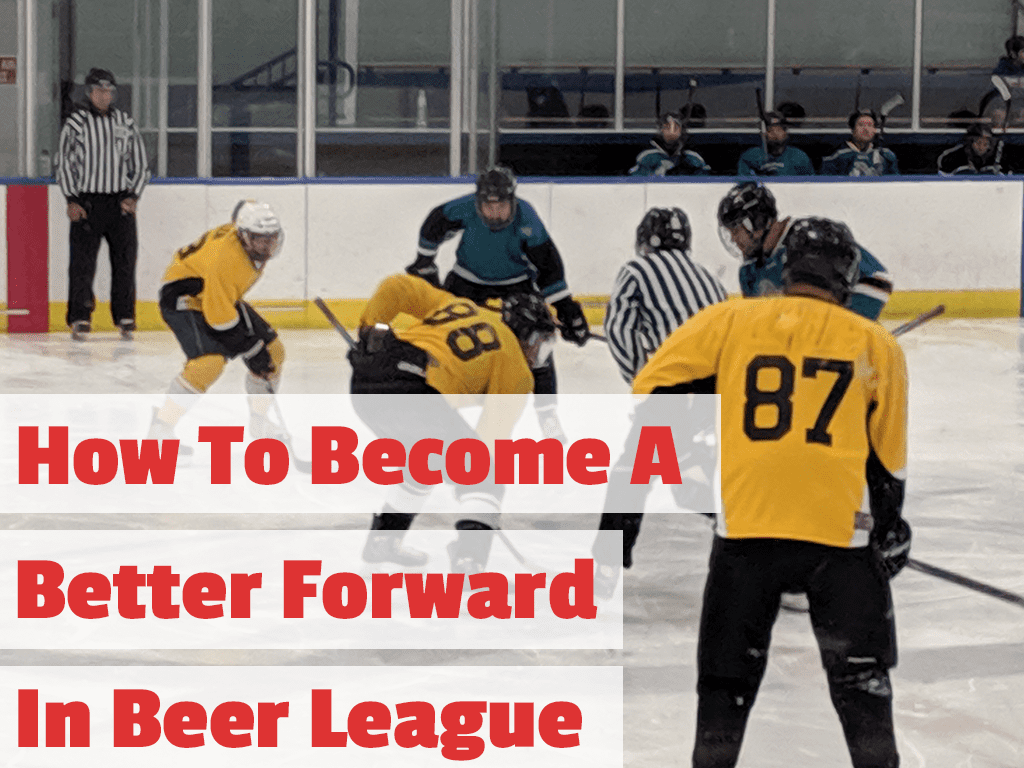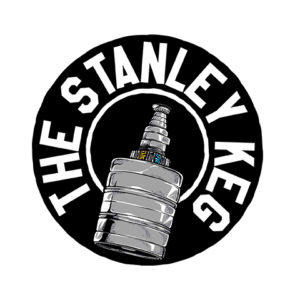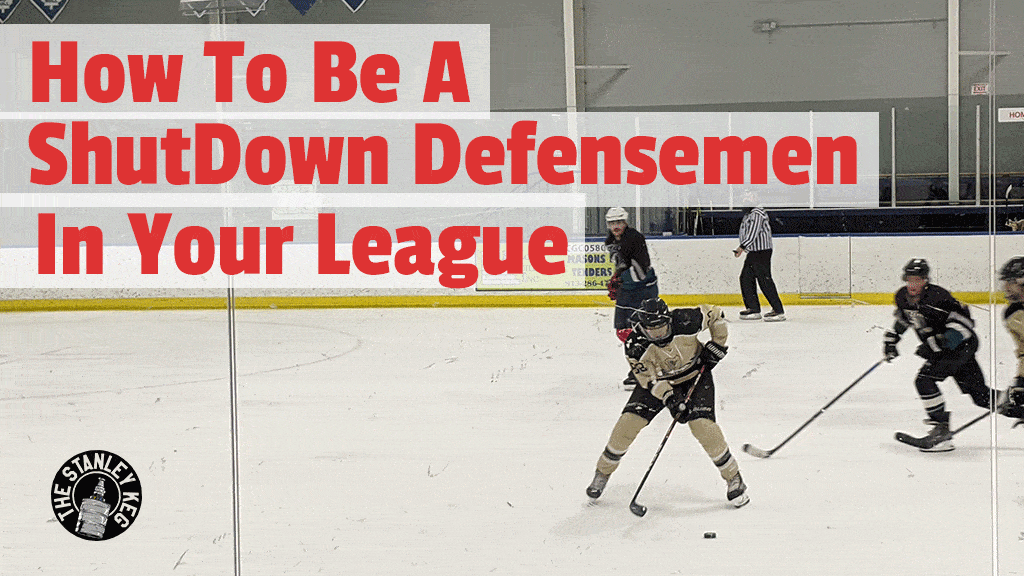
Playing Defense in beer league hockey can feel like a lot of pressure. You can’t let the other team score, if you get beat everyone will see it, It’s up to you to keep the crease clear. Well if you’re worried about playing defense on your beer league hockey team we’ve got some great tips to help you lock down the defensive zone.
The essential skills that you need in order to play rock-solid defense in beer league hockey are the ability to skate backward, positional awareness, being able to skate with the puck while your head is up, playing a physical game, and puck handling under pressure.
If you can begin to develop these skills you will be a lockdown defenseman on your beer league team. If you keep reading we will give you some game-time situations proving that these skills are the ones to focus on and give you some drills you can practice on and off the ice.
The Most Essential Skills A Defender Needs In Beer League Hockey
If you are like me, when you are playing defense for your team, you may be feeling lots of pressure not to screw up! You don’t want to be the reason why the other team scores.
That feeling of disappointment in yourself. It’s like you let the rest of the team down and its the worst.
But don’t worry! With these essential skills, you will be considered a shutdown defender around the league.
The very first skill that you need to improve upon is the ability to skate backward. This will really help you control the gap between you and the other players trying to skate into your zone. For example, most of the time when the other team is breaking out of their zone you are most likely facing their goalie. This means your back is to your goalie. The worst thing you can do is turn around, gain speed, and then turn around again to face the opposing player.
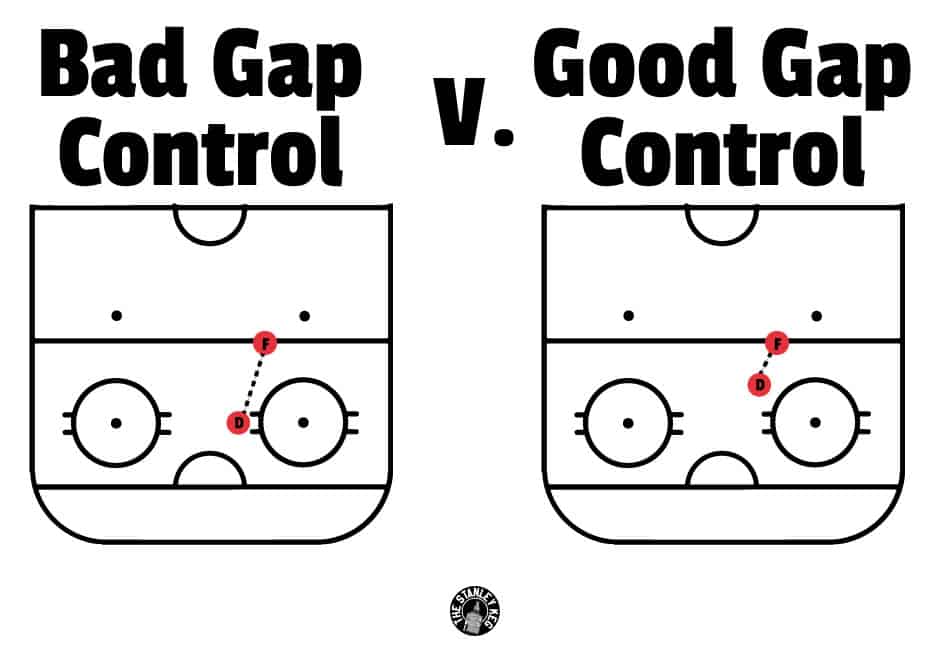
This gives that player all the power to do whatever they want to you. They could go left. They could go right. You wouldn’t know because your back is to that player.
Later in the article, we will talk about some drills you can practice to get better at picking up speed while skating backward.
Positional awareness is very important for a defender to understand. You and your defensive partner should be talking on the ice telling each other who has who. After you have your man that you need to be covering its important to not let them get inside positioning on you. Defend your house!
Speaking of defending your house, don’t be afraid to initiate contact. This does not mean that you can or should blast somebody on the ice. USA hockey does not allow body-checking when you lead with your hands, forearms, elbows, or your stick. However, USA hockey DOES allow and actually encourages what they call competitive contact at all age classifications.
Competitive contact refers to the physical contact that occurs between players during a hockey game. This type of contact is allowed as long as the players are in the vicinity of the puck and are actively trying to gain possession of it.
Examples of competitive contact include angling, where a defensive player directs the puck carrier towards a smaller area; physical engagement, where players lean into each other while chasing the puck; and collisions, which happen when players don’t mean to run into each other but do when chasing a puck.
It is also acceptable for a player to maintain their position on the ice and block their opponent’s access to the puck, as long as they do not use their arms or hands to hold or block the opponent.
You should also expect players on the other team to skate at you and use the competitive contact rule to their advantage too. This means you will need to be strong on your stick and avoid crumbling under pressure. I see it often, players will just throw the puck away when they feel the smallest bit of pressure.
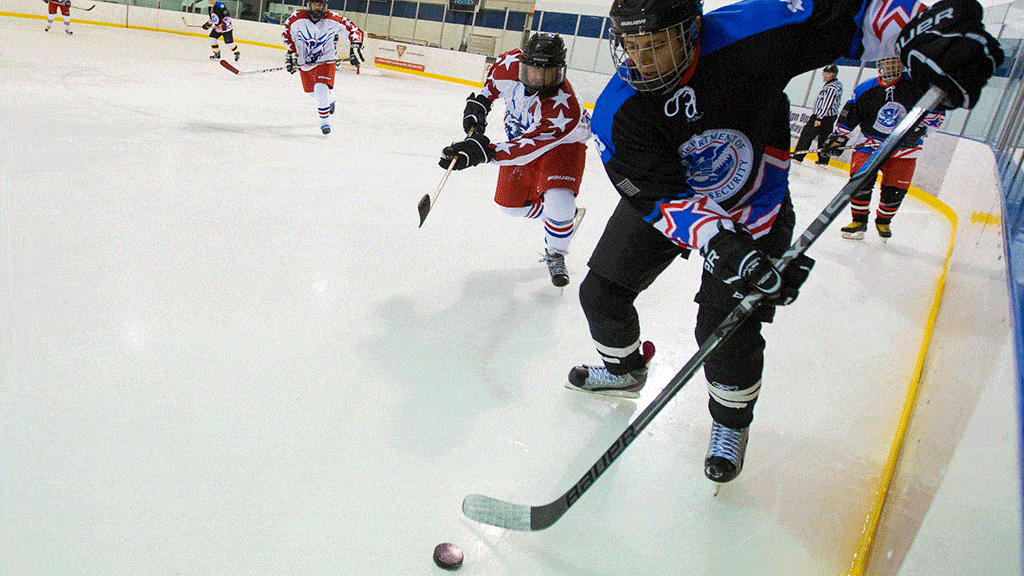
Just know that you have more time than you think you do. We will help you learn to use your body to protect the puck in a little bit.
The last essential skill to becoming a great defender is being able to skate with the puck while your head is up. This skill will really help you at any position on the ice but I have found it extremely helpful on defense. Often times you are gaining control of the puck behind the net and having to make a breakout pass.
I believe that making a good breakout pass is much more important than making a great pass in the offensive zone. If you mess up a breakout pass in your own zone the opposing team is already in a scoring position. However, if you miss a pass in the offensive zone the other team still has to skate 200 feet.
In the following sections, we will cover how to get better at each one of these must-have skills for playing defense in beer league hockey.
Defensive Schemes For Your Beer League Hockey Team
The best defensive scheme for your beer league hockey team is to understand that you need to communicate on the ice. It’s a two-man team when it comes to defense and you two should be in constant communication throughout your shifts.
Now, I know this isn’t actually a scheme but it will help you regardless of the scheme that you guys decide to play.
The easiest defensive scheme to execute in beer league hockey is man-to-man. Pick a man and stick with them throughout the play. Do not let your man get free and have a clean shot. That is your goal in the defensive zone.
If you are planning on leaving your man, holler out to your teammate and let them know. The only reason you should be leaving your man is if you think you can go and get the puck for your team.
The other defensive scheme that is easily executable in beer league hockey is called the 2-1-2. This scheme divides the ice up into 5 quadrants.
It’s basically playing zone defense.
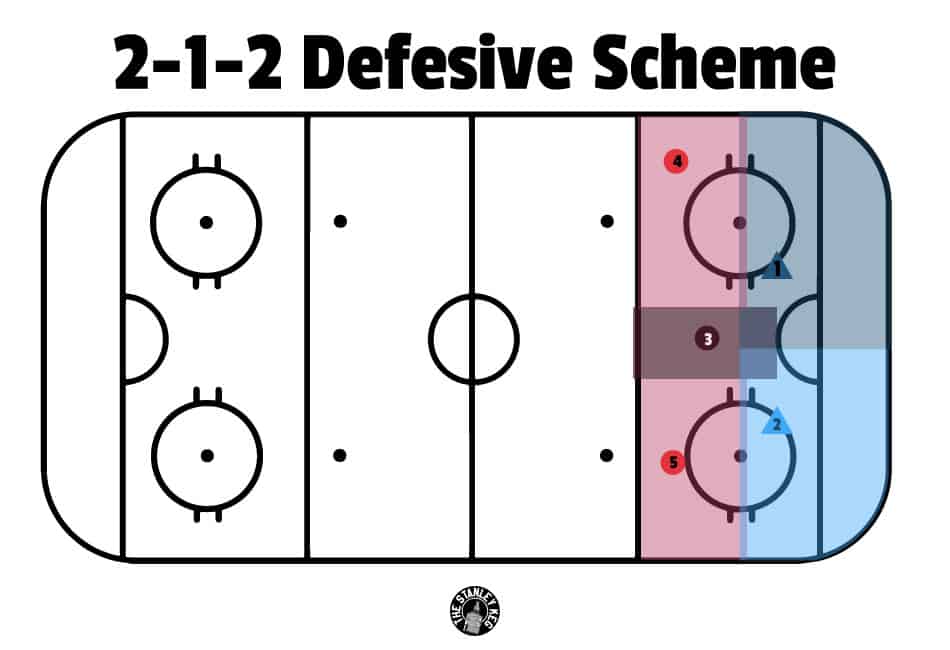
The defenders take the bottom corners and the sides of the net. The defenders responsibility is to clear out the front of the net and apply pressure to guys that skate behind the net.
The wingers take the top of the zones near the blue line and pressure defenders so that they can not get a clean shot from the point.
The center is responsible for covering the middleof the ice.This could be somebody in the high slot or a skater in crashing the net.
How To Play Defense In Odd Man Situations
If you are playing defense and your partner gets stuck up the ice it is up to you and the goalie to work out the best plan to play the odd-man situation right.
Most commonly goalies want you to take away the pass so that they can focus on the man with the puck.
This can mean skating between the two plays and laying out on the ice in order to block the pass or this could simply mean taking the stick away from the opposing player who does not have the puck. You do not want to literally remove their stick (this is obviously a penalty) but I mean taking your stick and tying it up with theirs. Do not allow them to get a clean shot off if the puck does happen to come their way.
However, every goalie is a little different. I have played with a goalie before that preferred when I attacked the puck carrier so that he couldn’t get a clean shot off. He was very confident with his ability to slide over and stop the shot from the pass.
It is very unusual for a goalie to actually want that, but it shows that it is always a good idea to talk to your goalie and get a good idea of what they are expecting you to do.
How To Develop Poise With The Puck
There is a good Reddit thread out there full of tips about skating with the puck and handling it under pressure.
I actually asked the question, what are some ways that you can think faster on the ice, or in other words not freak out when you have the puck and feel a tiny bit of pressure?
My favorite answer was actually the first reply.
A lot of it is just believing that you actually do have the time because most of the time you do. Pointlessly throwing the puck away in your defensive zone is a recipe for disaster and most of the time you have enough time to take a stride or two, assess the situation, and then make a decision.
Get into the habit of always taking at least one to two strides before throwing the puck off of your stick. This will help you build the habit of holding on to the puck a little bit more. Most of us freak out when the puck comes and form the habit of getting the puck away from us when we first started playing.
I still do it to this day! It is a hard habit to break if you are not consistently telling yourself to slow down, take a few strides, and assess what’s actually happening on the ice.
Now, if there is a mad scramble in front of the net, this advice may not be 100% accurate. The safe bet there is to throw the puck into the corner and go get it.
After retrieving the puck now you can tell yourself to skate with the puck and take a look around.
The more information that you can gather the better decision you can make.
Another great piece of advice is to learn to use your body to protect the puck. You would be surprised how well you can actually do this. Stick your butt out a little bit and always put your body between the puck and the other player.
If you have some practice time or heck, even in warm-ups, you and a teammate should play a keep away drill. Try to steal the puck from your teammate while they use their body to protect it. After you have stolen it now they can try to take it from you.
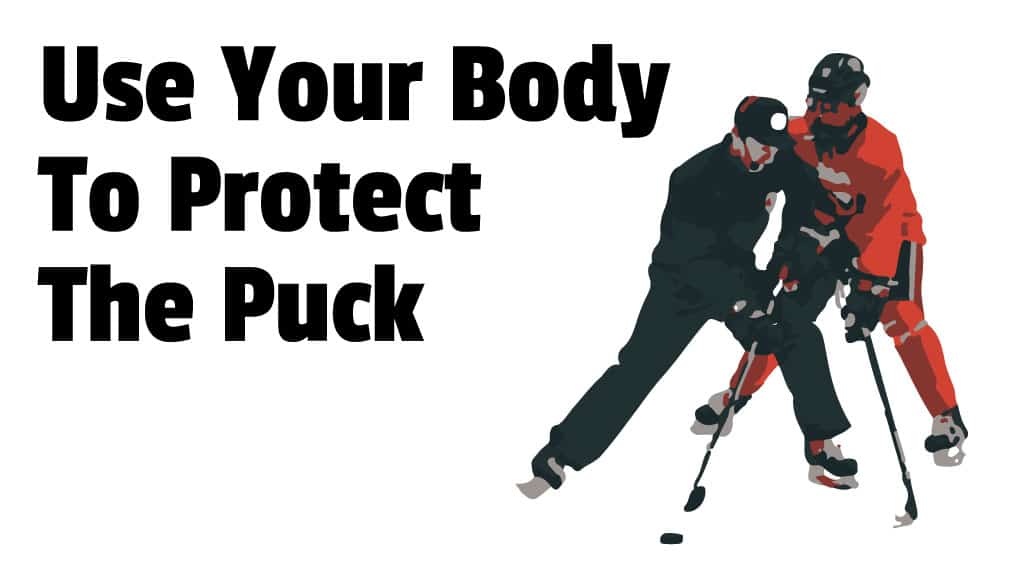
Think of using your butt. Seriously, stick your butt out and block the other player with it. Seems silly but it will definitely help you create some space.
This will help get the core warmed up but it will also show you some good ways to use your body and it will probably make you realize that someone can be a lot closer to you and not steal the puck than you thought.
How To Improve Your Backwards Skating
Being able to skate backward is an essential skill for playing defense.
If you aren’t confident with backward starts, crossovers or even controlling your speed
It can be scary to try some of these things in a game. Especially when you are the last man between the opponent and your goalie.
So here are some tips to improve your backward skating so that you can play defense in your beer league better.
I would recommend going to a stick and puck so that you can get some time to really focus on your edge work while skating backward
As with skating forward, you want to make sure that you stay balanced. When skating backward it’s really easy to lean too far forward and get on our toes too much. This will throw us off balance and cause us to lose control of our edges.
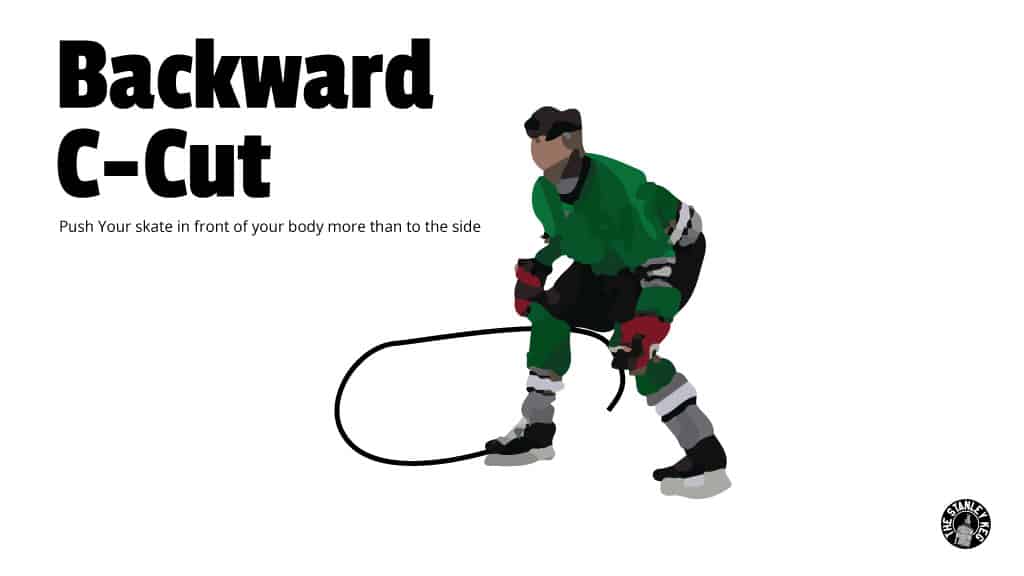
You want to make sure that you have enough pressure on your heels when skating backward to not allow your heels to lift off of the ice.
A fundamental skill for skating backward is being able to C cut. You can generate a lot of power and speed with the simple C cut. In fact, you see top-level NHL defensemen use it every single game.
[get a picture of a hockey player with their back to us and draw a c-cut shape to illustrate]
Perfecting the C cut is simple but not easy. The first step is knowing where to start. The perfect C cut will start with one leg pushing towards your front right (If looking forward is north, then you want to push to the northeast of your body). Think of pushing out with your toe and pulling back in with your heel. You want to go as wide as you feel comfortable with and you want to keep your other leg going as straight as possible.
Avoid pulling your cutting leg behind your opposite leg. This will cause you to lose speed.
After you are feeling comfortable with your C cuts it’s time to start focusing on isolating your inside and outside edges while going backward. A great drill to practice these are single-leg edge holds for your inside and outside.
To start we will focus on our inside edge.
- Begin skating backward from one net, heading toward the opposite net.
- Raise one leg and use the inside edge of your skate that is still on the ice to cut into the ice and have it turn you in a c shape so that you are now facing the boards.
- After you are turned, Plant your other foot, give a good c cut to generate speed, and raise the leg you were just on so that now you are balancing on the opposite leg from before;
- have that leg’s inside edge pull you around so that you are now facing the opposite side boards.
- Continue this pattern down the ice.
The outside edge drill is exactly the same as the inside edge drill but a lot more difficult. You will probably find yourself sliding on the ice and not being able to grip. At least that’s what I have found.
To fix this, think of putting more weight on your heels. Even visualize lifting your toes. This will force your weight to move back toward the center of your blade a bit more.
When doing these drills focus more on control than speed.
You want to be able to have control over your edges through the entire turn. You do not want to be whipping through these turns, that is not what this drill is about.
Lastly, focus on keeping your upper body movement to a minimum. If you are swinging your arms around all crazy, you will have a hard time keeping your balance
Don’t Be Afraid To Be A Little Physical In Front Of The Net
Playing defense means protecting the area in front of your net. I have seen so many goals scored because a defender was in the right spot but did not use their body or their stick to tie up their man.
It is well within the USA hockey rules to lean your body on another player in front of the net and tie up their stick with yours.
This does not mean that you should put your stick on their lower back, this also does not mean that you should be hooking their hands.
The perfect defense is to keep your stick on the ground, intertwined with the opponent’s stick while you lean your shoulder into the body. Put enough pressure on them to make them uncomfortable and not able to get a clean shot off.
Your goalie will really appreciate it when you clear people out of their line of sight as well. Again, I am not saying to go up and blast some guy parked in front of your net. But what I am saying is put your body on him, lean into him and move your legs, you can move somebody from in front of the net without cross-checking or body-checking them.
This is never a bad play. This means that you have taken your man out of the play and given your goalie a clean look at the puck.
So don’t be afraid to use your body, this is also true when not in front of the net. As long as both players are clearly going for the puck you are allowed to use your body to angle them off of the puck. You can put your hips between a player and the puck and it is 100% legal according to USA hockey.
I think too many players assume that since most adult hockey leagues are nonchecking that this also means no contact but that is just not true. In fact, USA hockey encourages safe competitive contact for the puck.
Being A Great Defender For Your Beer League Hockey Team
Being a great defender in beer league hockey comes down to being confident with your ability to skate backward, making sure you and your teammates are on the same page when it comes to a defensive scheme, having poise with the puck, and using your body to angle other players off from the puck and keep your net clear.
When I first started playing defense I felt a lot of pressure. It felt like my mistakes would be highlighted because usually if you get burnt on defense the other team is getting a prime scoring chance.
All of this is mostly true. There is a bit more pressure when playing defense compared to the wing. Some players thrive with the pressure and rise to the occasion while others do not like to have that weight on their shoulders.
No matter what though if you can get decent at skating backward, and learn to use your body with and without the puck you will be a much better defender than a player who does not do these things. So if you want to get good at playing defense I would suggest taking some time and working on developing your edge control while skating backward.
You will also see a huge improvement in your game if you get in the habit of reminding yourself that you have more time than you think you do when the puck is on your stick. There is no need to blindly throw the puck away, especially in your zone. Keep your head up, take a few strides, and then move the puck.
If you can get better at these few fundamentals you will not only be a shutdown defenseman in your league but you will be a much better hockey player no matter the position you may end up playing.
